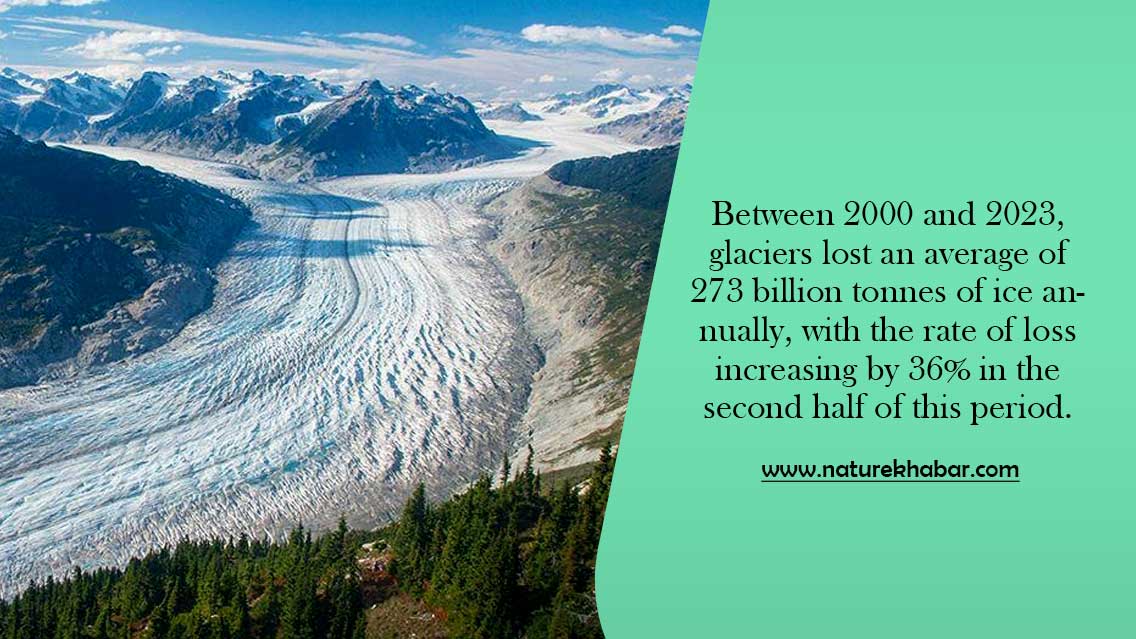Glaciers in Peril ! 548 Billion Tons of Ice Vanish in a Year
- Pitambar Sigdel

Kathmandu - A groundbreaking study published in Nature has revealed that glaciers worldwide are melting at an unprecedented rate, contributing significantly to rising sea levels. Between 2000 and 2023, glaciers lost an average of 273 billion tonnes of ice annually, with the rate of loss increasing by 36% in the second half of this period.This massive ice loss has added approximately 18 millimeters to global sea levels over the past two decades, with the last five years (2019-2023) seeing the highest annual ice loss on record. In 2023 alone, glaciers lost a staggering 548 billion tonnes of ice, the highest single-year loss ever recorded.
Glaciers have lost between 2% and 39% of their ice regionally since 2000, with a global average loss of about 5%. The total ice loss from 2000 to 2023 amounts to 6,542 billion tonnes, equivalent to filling over 2.6 billion Olympic-sized swimming pools. The largest contributors to global ice loss are Alaska (22%), the Canadian Arctic (20%), Greenland’s peripheral glaciers (13%), and the Southern Andes (10%). Regions with smaller glaciers, such as Central Europe and the Caucasus, have experienced the highest percentage of ice loss, with Central Europe losing 39% of its glacier ice since 2000.
Glacier melt has contributed 0.75 millimeters per year to global sea level rise, accounting for 20% of the total rise observed between 2003 and 2016. This is more than the contributions from the Greenland Ice Sheet (17%) and nearly double that of the Antarctic Ice Sheet. The rate of ice loss increased from 231 billion tonnes per year between 2000 and 2011 to 314 billion tonnes per year between 2012 and 2023. The years 2019 to 2023 saw the four highest annual ice loss records, with 2023 marking the peak at 548 billion tonnes.
The primary cause of glacier melt is rising global temperatures due to human-induced climate change. Regional climate patterns, such as warming temperatures and changes in precipitation, have also played a role in accelerating ice loss in specific areas. Glaciers are critical components of Earth’s climate system. Their melting not only contributes to sea level rise but also impacts freshwater resources, ecosystems, and local communities. Many regions rely on glacier meltwater for drinking water, agriculture, and hydropower.
As glaciers shrink, these resources are at risk. Melting glaciers also increase the risk of landslides, floods, and other geohazards, particularly in mountainous regions, while disrupting habitats and biodiversity.
The study emphasizes the urgent need for global action to address climate change. Reducing greenhouse gas emissions is critical to slowing the rate of glacier melt and mitigating its impacts. The findings also highlight the importance of continued monitoring and research to better understand glacier dynamics and improve climate models. The world’s glaciers are melting faster than ever, and their loss is a stark reminder of the ongoing climate crisis. Without immediate and sustained efforts to combat climate change, the consequences of glacier melt—rising seas, water shortages, and environmental disruptions—will only worsen in the coming decades.
The study, led by the GlaMBIE Team, represents a collaborative effort involving over 450 data contributors from 35 research teams worldwide. It provides the most comprehensive assessment of glacier mass changes to date, offering a refined baseline for future climate models and policy decisions. The study combined data from four main methods: glaciological measurements, digital elevation model (DEM) differencing, altimetry, and gravimetry. These methods provided a comprehensive view of glacier changes, though each has its limitations in terms of spatial and temporal resolution. While all 19 glacier regions studied experienced ice loss, some regions, like South Asia west, saw slower rates of loss due to regional cooling and increased winter precipitation. In contrast, regions like the Southern Andes and New Zealand experienced some of the highest rates of ice loss.
Glacier mass loss is 18% larger than the loss from the Greenland Ice Sheet and more than twice that from the Antarctic Ice Sheet. Even under low-emission scenarios, glaciers will continue to lose mass due to the delayed response of glaciers to climate change. By 2100, 25-54% of global glacier mass could be lost, depending on future greenhouse gas emissions. The rapid melting of glaciers is a clear signal of the ongoing climate crisis. Immediate action is needed to reduce emissions and mitigate the impacts of glacier loss on sea levels, freshwater resources, and ecosystems. The findings of this study underscore the urgency of global efforts to combat climate change and protect our planet’s icy landscapes.
https://www.nature.com/articles/s41586-024-08545-z




Feedback